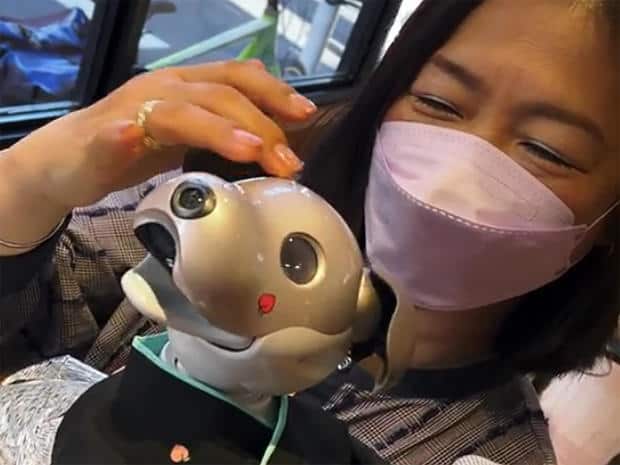
TOKYO — As pandemic-led isolation triggers an epidemic of loneliness, Japanese are increasingly turning to “social robots” for solace and mental healing.
At the city’s Penguin Cafe, proud owners of the electronic dog Aibo gathered recently with their cyber-pups in Snuglis and fancy carryalls. From camera-embedded snouts to their sensor-packed paws, these high-tech hounds are nothing less than members of the family, despite a price tag of close to $3,000 — mandatory cloud plan not included.
It’s no wonder Aibo has pawed its way into hearts and minds. Re-launched in 2017, Aibo’s artificial intelligence-driven personality is minutely shaped by the whims and habits of its owner, building the kind of intense emotional attachments usually associated with kids, or beloved pets.
Noriko Yamada rushed to order one, when her mother-in-law began showing signs of dementia several years ago. “Mother had stopped smiling and talking,” she told CBS News. “But when we switched the dog on, and it gazed up at her, she just lit up. Her behavior changed 180 degrees.”
And a few months ago, when the mother-in-law was hospitalized for heart disease, Koro the robot again came to the rescue. “Because of COVID, we couldn’t visit her. The nurse said Mother was responding to pictures of Koro, and asked us to bring in the dog. So, Koro was the last person in our family to see Mother alive.”
Robots as companions are an easier leap for Japanese, many manufacturers and users say, because the country is steeped in friendly androids, like the long-running TV cartoon “Doraemon,” in which a cute, roly-poly pal provides not only constant company, but an endless supply of useful tricks.
But one robot startup is proving looks aren’t everything. Despite having neither head, arms nor legs, the Qoobo bot sold more than 30,000 units by September, many to stressed-out users working from home under COVID restrictions. The retail price starts at about $200.
Yukai Engineering CEO Shunsuke Aoki told CBS News that Qoobo leverages the most pleasing parts of a pet — a fluffy torso, and a wagging tail. “At first, it seemed weird,” he said. “But when you pet an animal like a cat, you usually don’t bother to look at its face.”
Frazzled adults aren’t the only Japanese turning to robots. At Moriyama Kindergarten in the central Japanese city of Nagoya, robots are replacing the traditional class guinea pig or bunny. Teachers told CBS News that the bots reduce anxiety and teach kids to be more humane.
Two years ago, the preschool bought a pair of Lovot brand bots named Rice Cake and Cocoa. Weighing as much as an infant, with the price tag of a French bulldog, the cybernetic machines are designed to love-bomb their owners — or, in this case, a roomful of fidgety five-year-olds.
“Our kids think the robots are alive,” said principal Kyoshin Kodama. “The bots have encouraged the kids to take better care of things, be kinder to each other, and cooperate more.”
Lovot is a so-called “emotional robot” programmed to autonomously navigate its surroundings, remember its owners and respond to hugs and other affection, gazing out with its oversized, quivering, high-resolution eyes. Over the last year sales have jumped 11-fold.
“Their body temperature is set to 98.6 degrees,” Groove X company spokesperson Miki Ikegami told CBS News. “Robots are usually hard, cold and inhuman. But since our bots are built to soothe, we made them warm and soft.”
Japan’s oldest and most successful social robot is an FDA-approved device called Paro.
Resembling an ordinary plush toy, the artificial intelligence-powered bot customizes its response as it gets to “know” each patient. Inventor Takanori Shibata, based at Japan’s National Institute of Advanced Industrial Science and Technology, told CBS News that clinical trials have backed the device’s benefits as a non-drug therapy. “Interaction with Paro can improve depression, anxiety, pain and also improve the mood of the person.”
Since launching in 1998, thousands of Paro robots have gone into service, worldwide, relieving stress among children in ICUs, treating U.S. veterans suffering from PTSD, and helping dementia patients.
Like real flesh-and-blood pets, Paro has been shown to stimulate brain activity, helping reconnect damaged areas. “One lady didn’t speak for more than ten years,” Shibata said. “When she interacted with Paro, she started to talk to Paro and she recovered her speech and she spoke to others.”
Neuroscientist Julie Robillard, who studies social robots for children and seniors, told CBS News that robotics experts are trying to tease out the exact nature of the human-robot relationship — and the notion of machines as friends is not as farfetched as it might seem.
“We can be attached to various types of devices and objects,” said Robillard, an assistant professor of neurology at the University of British Columbia. “Some people have given names to their robot vacuums … Some people feel strongly about their cars or about their wedding bands.”
Evidence supports the use of social robots, she said, in areas like imparting social skills to children with autism, or teaching exercises to rehab patients – offering instruction without judgment.
But in other areas, it’s unclear how well social robots really work, she said. “What we can say from the science right now is that robots have a huge amount of potential.”
And discovering that potential is all the more urgent now, in the covid era, as robots offer the promise of social connection without social contact.
Creators say intelligent social robots will never replace humans. But when companions, caregivers or therapists aren’t available, robots are lending a friendly paw – and are already earning their keep.